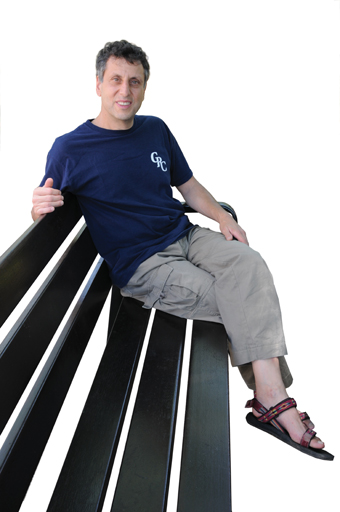Are you a journalist? Please sign up here for our press releases
Subscribe to our monthly newsletter:

Charles Darwin realized that it's not money but mutations that make the world go round. Mutations drive evolution: They alter gene sequences, tweaking the function of their protein products and assuring the adaptability of organisms to ever-changing environments.
In nature, proteins are able to evolve new functions surprisingly rapidly and efficiently. In contrast, scientists who try to evolve proteins in the test tube do not fare as well. One snag lies in the precise 3-D structures proteins must get folded into before they can function. These structures are very fragile, so introducing even a minor mutation can undermine the protein’s stability, causing it to misfold. To protect the organism, many such mutations – including those with the potential to endow proteins with new functions – are purged. “Like throwing the baby out with the bath water, the future potential for adaptation is also destroyed, and this severely limits the rate of protein evolution,” says Prof. Dan Tawfik of the Weizmann Institute’s Biological Chemistry Department.
Scientists are keen on revealing how nature deals with these mutations because the ability to evolve proteins in the laboratory – so-called “directed evolution” – provides a powerful means for engineering tailor-made enzymes (proteins that speed up chemical reactions) with novel properties for a range of industrial, biotechnological and medical applications.
It turns out that in living cells these trouble-prone proteins are accompanied by chaperones – protein babysitters that help newly-synthesized proteins fold into the correct 3-D structures and later save them when they get into hot water – literally. When a cell undergoes such environmental stress as exposure to high temperatures, causing proteins to misfold, high numbers of chaperones are induced to rescue the misfolded proteins and help the cell survive the so-called heat shock.
Tawfik wondered whether these same chaperones could perform a similar function in the lab: keeping mutated proteins out of trouble and thus accelerating directed protein evolution. To find out, postdoctoral fellow Dr. Nobuhiko Tokuriki carried out directed evolution experiments, introducing random mutations in selected enzymes, both in the presence and absence of large amounts of a chaperone from the bacterium E. coli, called GroEL/GroES.
In a research article recently published in Nature and featured in its “Making the Paper” section, Tawfik and Tokuriki showed that the chaperones seemed to buffer the effects of many mutations and, in doing so, were able to save about one-third of the mutated proteins that would otherwise have perished. This, in turn, enabled proteins to acquire twice as many mutations, promoting genetic diversity and accelerating the rate at which they acquired new functions through generations of evolution. What’s more, the evolved proteins that had chaperone help were, on average, 10 times more active and more specifically adapted to their tasks than their chaperoneless cousins.
Tawfik: “These results are quite striking. Although the scientific community suspected that chaperones could play a role in salvaging mutated proteins, there was no systematic evidence to support the idea, let alone the remarkably high extent of their rescue capabilities.”
Two hundred years after Darwin’s birth, this work adds another detail to the evolutionary picture, providing direct evidence that protein stability is, indeed, a major constraint in protein evolution and that buffering mechanisms such as chaperones are key in alleviating such constraints.
In light of this research, chaperones will almost certainly be used routinely by those trying to produce more powerful enzymes for biotechnical applications. Tawfik: “Whether evolving in nature or the lab, if you’re not fast you’ll never make it to the finish line.”
Prof. Dan Tawfik’s research is supported by the J&R Center for Scientific Research; the Willner Family Leadership Institute for the Weizmann Institute of Science; the Sassoon and Marjorie Peress Philanthropic Fund; the Jack Wolgin Prize for Scientific Excellence; Miel de Botton Aynsley, UK; Mario Fleck, Brazil; Mr. and Mrs. Yossie Hollander, Israel; Roberto and Renata Ruhman, Brazil; David Rosenberg, Houston, TX; Charles Rothschild, Brazil; and Rowland Schaefer, New York, NY.
 Tokurik.jpg)
Nobuhiko (Nobu) Tokuriki became interested in science at a young age – especially evolution. During his undergraduate studies, he learned of directed evolution and knew that was what he wanted to research. Impressed by Tawfik’s work, Nobu contacted him at the University of Cambridge, UK, and asked if he could conduct his postdoctoral studies in Tawfik’s lab. Tawfik agreed, although there was one catch – he had already moved back to Israel to conduct research at the Weizmann Institute. “I had hardly heard of Israel, let alone the Weizmann Institute, before I contacted Danny, but I thought, why not, it could be an interesting experience,” says Nobu. And he was not disappointed: “It was certainly an amazing experience to work in such a fine institute, with many great scientists, lots of activity and a wonderful atmosphere. Also, being the only Japanese student at that time was an experience in itself: Apart from comparing various cultural differences, I also had the honor of being asked to meet a Japanese ambassador, Japanese diplomats and various other visitors from Japan.”
Since then, Nobu has come full circle and is continuing his research at the University of Cambridge, UK.